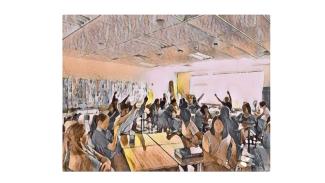
Figure caption: Rendition (to preserve privacy) of a photograph taken of her classroom by a teacher in the USA after reading Professor Leighton’s 2016 article, and equipping her smartphone following Professor Leighton’s instructions, and those of her class who can hear the disturbing ultrasound to point to its location.
As part of his wider scientific interests, Professor Leighton recently co-authored international guidelines on the safety to humans of airborne ultrasound, and on maximum safe exposures. It is important to ensure that there are guidelines in place that industries and building managers can follow in order to ensure the safety of people.
Interest in the area for workplace exposures had been ongoing since the 1940s, but the evidence base was weak and often discredited. The last guidelines were labelled ‘interim’ and, although published 40 years ago, were never revisited or revised. However, in 2016 Professor Leighton became the first person to publish on the use of airborne ultrasound in public places, exposing the public without their knowledge through the use of common devices. It had been postulated that such exposures could lead to failure to concentrate, headache, nausea, dizziness, tinnitus (and, at extremely high levels not seen in public to date, temporary or permanent damage to hearing, and at even higher levels to painful burning).
Following the 2016 paper, Professor Leighton began trying to persuade policymakers to take the matter seriously, which included appearances on BBC Radio 4’s ‘The Today programme’, and on BBC Radio 2 and Radio 5, and on radio shows in Ireland, Wave 105 FM, BBC Radio Solent, The Naked Scientists, BBC Radio Scotland. Because of this, he was also following claims (probably unfounded) of an ultrasonic attack on the US Embassy in Cuba, on BBC Radio 5, and on TV programs for BBC World and the New York Times, in Turkey.
At the levels that Professor Leighton was measuring, the lower-level effects on a subset of humans (such as failure to concentrate and annoyance) might be expected. As Professor Leighton pointed out, if these were to occur in the school classroom, the workplace or the home, detriment to work, sleep and health over the long term would be very undesirable. Only a minority of the population would suffer as a result, with most being unaffected and unaware of the exposure. The fact that usually the member of the public did not know the source of the problem, or that they had been exposed to airborne ultrasound, and their colleagues and families occupying the same location at the same time felt no ill effects, led to isolation in sufferers who were disbelieved, or to individuals being labelled in the school or workplace as malingerers or ‘difficult’.
The school classroom was of particular concern, so that children might be adversely affected in teaching day-in day-out, whereas the teacher and their classmates would be unaware of any exposure. This proposed scenario proved to be correct. Professor Leighton advertised how to adapt a smartphone (see video and Appendix A to the 2016 paper) to detect such ultrasound in air, which resulted in the public tracking down sources of problems, from Australia to Japan to the USA. This was particularly beneficial, because with only a minority of the public suffering adverse reactions, they tended to be disbelieved by family and co-workers who occupied the same location at the same time. The benefit was highlighted when a teacher in USA used his method to equip her smartphone to identify why a minority of her class were finding it difficult to engage in lessons, the source of the problematic ultrasonic emissions being an electronic device in the ceiling. The image shows a rendition (to preserve privacy) of a photograph taken in her classroom by a teacher in the USA after reading Professor Leighton’s 2016 article, and equipping her smartphone following Professor Leighton’s instructions, and those of her class who can hear the disturbing ultrasound to point to its location.
Professor Leighton’s advocacy, though papers in 2016, 2017 and 2018, and his chairing special sessions on the topic at international conferences and in the scientific journals, led to international effort to provide useful guidelines, most recently culminating in the International Commission for Non-Ionizing Radiation Protection publishing guidance on the issue, after engaging him as Scientific Expert. Furthermore, the International Standards Organisation has set up a committee to investigation standardization in measuring such airborne ultrasonic emissions so that device outputs and public exposures can be measured around the world in a standardized manner.
The reference for the new guidelines is:
Karipidis, K., Abramowicz, J., Hirata, A., Kuhne, J., Leighton, T. G., Oftedal, G., Radosz, J., Röösli, M., Croft, R., van Rongen, E., Cridland, N., Huss, A., d'Inzeo, G., Marino, C., Watanabe, S. (2024) Validity of the 1984 Interim Guidelines on Airborne Ultrasound and Gaps in the Current Knowledge. Health Physics (doi: 10.1097/HP.0000000000001800).
Figure caption: Dr Mengyang Zhu measures levels of ultrasound emitted into a public place by a Public Address Voice Alarm (PAVA) system when it is supposed to be making no emissions.